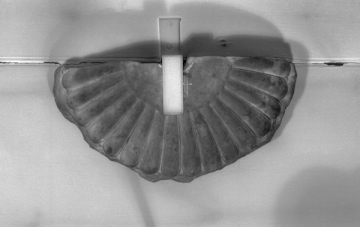Explore Collections


You are here:
CollectionsOnline
/
Fragment of the top basin of a Roman candelabrum
Browse
Fragment of the top basin of a Roman candelabrum
Marble, probably Italian marble
Diameter: 36cm
Depth: 10cm
Depth: 10cm
Museum number: S7
On display: Study - ceiling
All spaces are in No. 13 Lincoln's Inn Fields unless identified as in No. 12, Soane's first house.
For tours https://www.soane.org/your-visit
Curatorial note
Broken half of a round, fluted dish - the top of a large candelabrum complex - the dish for burning oil or some similar substance, perhaps incense. The candelabrum creations from antique fragments, so beloved by Eighteenth Century connoisseurs under the spell of Piranesi, often terminate in such a small marble bowl1 as do antique examples. The eight examples of Piranesi-type candelabrum ensembles illustrated by Gusman in Chapter VII of Villa Hadriana indicate that, as with other categories of the Soane and Tatham-Holland collections, we may assume a like provenance for at least some of the candelabrum fragments which follow.2
1For example: G.B. Piranesi, Vasi, candelabri, cippi, sarcofagi tripodi, lucerne, ed ornamenti antichi, Rome, 1779 plates 96, 100, 101, 107, 108; and the most famous pair, the great Barberini candelabra in the Vatican, plates 50, 51; P. Gusman, La Villa impériale de Tibur (Villa Hadriana), Paris, 1904, fig. 414 f., where the bowls appear to both be ancient and to belong with the supports. See also Wilton-Ely, Piranesi, WE 935/936 - the candelabrum in the Vatican. Other candelabra in Wilton-Ely, Piranesi, for comparison: WE 382, 910, 911, 912, 991, 992, 995, 996, 1002, 1003. As most of the candelabra today are 18th Century 'restorations' authentic examples for reference might be found in 'illustrations' like Pompeian wall paintings or the candelabrum shown in the relief of the narrow side of the Caffarelli sarcophagus in Berlin see Cain, 1985, plates. 2 and 5. Good examples are the candelabra found in the ship wreck at Mahdia. See A. Merlin and L. Poinssot, Cratères et candélabres de marbre trouvés en mer près de Mahdia, Tunis and Paris, 1930.
2 For general information on Roman candelabra see: Hans-Ulrich Cain, Römische Marmorkandelaber, Mainz, 1985.
1For example: G.B. Piranesi, Vasi, candelabri, cippi, sarcofagi tripodi, lucerne, ed ornamenti antichi, Rome, 1779 plates 96, 100, 101, 107, 108; and the most famous pair, the great Barberini candelabra in the Vatican, plates 50, 51; P. Gusman, La Villa impériale de Tibur (Villa Hadriana), Paris, 1904, fig. 414 f., where the bowls appear to both be ancient and to belong with the supports. See also Wilton-Ely, Piranesi, WE 935/936 - the candelabrum in the Vatican. Other candelabra in Wilton-Ely, Piranesi, for comparison: WE 382, 910, 911, 912, 991, 992, 995, 996, 1002, 1003. As most of the candelabra today are 18th Century 'restorations' authentic examples for reference might be found in 'illustrations' like Pompeian wall paintings or the candelabrum shown in the relief of the narrow side of the Caffarelli sarcophagus in Berlin see Cain, 1985, plates. 2 and 5. Good examples are the candelabra found in the ship wreck at Mahdia. See A. Merlin and L. Poinssot, Cratères et candélabres de marbre trouvés en mer près de Mahdia, Tunis and Paris, 1930.
2 For general information on Roman candelabra see: Hans-Ulrich Cain, Römische Marmorkandelaber, Mainz, 1985.
Rome; collected in Rome by Charles Heathcote Tatham for the architect Henry Holland during the 1790s. See Cornelius Vermeule, unpublished catalogue of the Antiquities at Sir John Soane's Museum, Introduction, transcription of Tatham letters, List 3, no.15 (SM Archive)
Literature
Tatham: Drawings, 8, no.15.
Soane collections online is being continually updated. If you wish to find out more or if you have any further information about this object please contact us: worksofart@soane.org.uk


